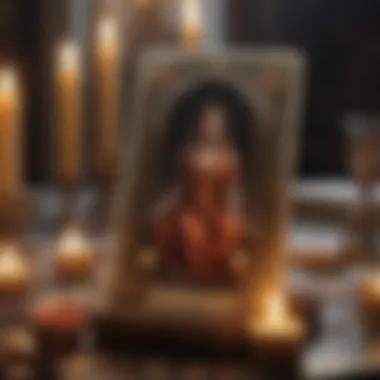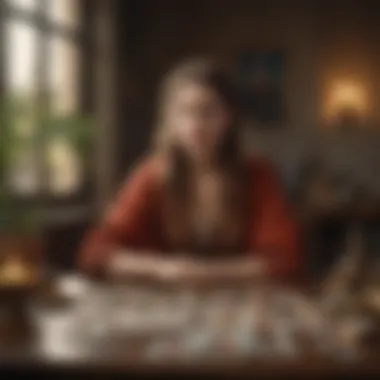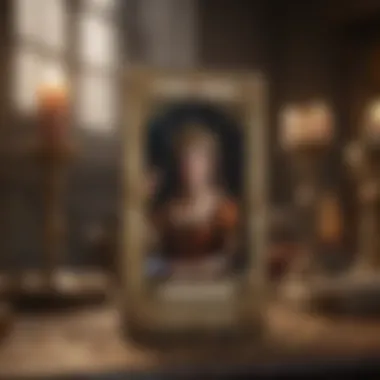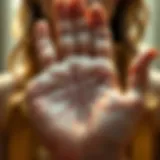A Comprehensive Tarot Card Study Guide for All Levels


Intro
Tarot cards represent a complex and multifaceted system that goes beyond mere fortune-telling. They engage with the psyche and spirit, aiming to unlock hidden truths and provide guidance. This guide presents the fundamental aspects of tarot, including its rich history, essential card meanings, and practical methods for effective readings. By gaining a deeper understanding of tarot, both newcomers and seasoned practitioners can enhance their intuitive skills and personal growth.
Astrological Concepts
Astrology and tarot often intersect, creating a deeper context for interpreting the cards. Understanding key astrological concepts can enhance one's appreciation for tarot readings and their implications.
Definition of Key Terms
Astrology involves the study of celestial bodies and their influence on human events. Some key terms include:
- Zodiac: A circle of twelve signs, each corresponding to specific dates and traits.
- House: Divisions of an astrological chart, each representing different areas of life.
- Aspect: Angles formed between planets, affecting their interaction.
Historical Background of Astrology
Astrology dates back thousands of years. Ancient civilizations, such as the Babylonians and Egyptians, used astrological systems for agriculture, navigation, and even political decisions. As time progressed, various cultures adapted astrology to fit their unique beliefs and practices.
Overview of Different Astrology Branches
Astrology has several branches, and each offers unique insights.
- Natal Astrology: Focuses on an individual's birth chart, unveiling personal traits and life paths.
- Mundane Astrology: Examines world events and societal trends through celestial patterns.
- Horary Astrology: Provides answers to specific questions based on the position of the planets at the time of inquiry.
Zodiac Signs Exploration
The zodiac consists of twelve signs, each possessing distinct characteristics and associations.
In-Depth Analysis of Each Sign
Understanding the nuances of each zodiac sign enriches tarot readings. Each sign connects with specific tarot cards, influencing the interpretation of their meanings during a reading.
- Aries: Represents courage and impulsiveness. Associated card: The Emperor.
- Taurus: Symbolizes stability and sensuality. Associated card: The Hierophant.
Personality Traits and Characteristics
Each sign embodies a range of personality traits:
- Gemini: Quick-witted and adaptable but may struggle with indecision.
- Cancer: Nurturing and intuitive but prone to mood swings.
Historical and Mythological Connections
Historical figures often align with zodiac signs, reflecting their traits in mythology. For instance, Leo's bravery connects to the lion in Greek mythology, symbolizing strength and leadership.
Celestial Events
Celestial events profoundly impact astrology and tarot practices. Understanding these can enhance readings.
Major Cosmic Phenomena
Astrological phenomena include eclipses, retrogrades, and planetary transits. Each carries specific meanings that can shape our understanding of tarot.
Impact of Celestial Events on Astrology
Celestial events can affect personal energies. For example, a Mercury retrograde often suggests a time for reflection and reassessment, affecting tarot readings at that period.
Rituals and Practices During Celestial Events
Many practitioners perform rituals during significant celestial events to harness their energy. Common practices may include:
- Setting intentions during a new moon.
- Releasing negativity during a full moon.
Prolusion to Tarot
The Introduction to Tarot lays the fundamental groundwork for understanding this intricate system of divination. Tarot is more than just a collection of cards; it embodies a rich tapestry of history, symbolism, and practical usage. This section emphasizes the significance of Tarot as a tool for insight, self-reflection, and personal growth. For both novice users and seasoned practitioners, grasping the core concepts of Tarot enhances the overall reading experience.
History of Tarot
The history of Tarot spans centuries, with its origins shrouded in mystery. Initially believed to have emerged in the 15th century as playing cards in Europe, they were not utilized for divination until much later. In the 18th century, Tarot underwent a significant transformation as mystics and occultists began to ascribe deeper meanings to the cards. Scholars suggest that Tarot's roots may trace back to ancient cultures, incorporating aspects of Egyptian, Hebrew, and even Greek traditions. Many Tarot historians advocate for this profound connection to early esoteric knowledge.
Through varied cultural lenses, Tarot reflects humanity's collective psyche. It was not until the 19th century that Tarot was widely regarded as a divination tool, leading to its popularization in spiritual and esoteric circles. Key events, such as the publication of the Rider-Waite-Smith deck in 1909, marked a turning point, bringing Tarot into mainstream consciousness and establishing standardized card meanings. Understanding this history is vital, as it informs modern interpretations and practices.
Understanding Tarot in a Modern Context
In today's fast-paced world, Tarot has found a niche as a versatile method for personal exploration and decision making. It serves not only as a spiritual practice but also as a practical tool for coping with life's complexities. Many practitioners emphasize that Tarot offers valuable insights into one's subconscious, revealing hidden thoughts and feelings.
Additionally, the popularity of social media has transformed how people engage with Tarot. Platforms like Reddit and Facebook have fostered vibrant communities where individuals share interpretations, personal stories, and reading techniques. In this context, Tarot is seen as a dialogue rather than a monologue, a way to connect with others and gain diverse perspectives on self-improvement and emotional wisdom.
Tarot is not merely luck or superstition, but rather a reflection of one's internal landscape.


Overall, recognizing modern Tarot practice is crucial for any aspiring reader. It keeps pace with changing societal norms and understands new generations' needs and queries. With psychological insights at its core, Tarot becomes a mirror—showing the past, illuminating the present, and suggesting potential paths forward. This adaptability ensures that Tarot remains relevant, functional, and compelling in navigating the complexities of contemporary life.
Structure of a Tarot Deck
Understanding the structure of a tarot deck is essential for anyone delving into the world of tarot. It provides a detailed framework that helps in effective readings and enriches the overall practice. A complete tarot deck contains 78 cards, which are categorized into the Major Arcana and Minor Arcana. Each category serves a distinct purpose and offers unique insights. This structure contributes to the deck's relevance everything from choosing a deck to interpreting its meanings.
Major Arcana Overview
The Major Arcana consists of 22 cards, which are often seen as the core of the tarot deck. Each card represents profound life lessons, spiritual themes, and archetypal energies. Cards such as The Fool, The High Priestess, and The World communicate key aspects of the human experience. They tell stories that resonate across time and culture.
Their importance lies in their ability to capture the essence of life's journeys. When drawn in a reading, Major Arcana cards often indicate significant events or shifts. They stimulate reflection and can catalyze personal insight.
Minor Arcana Overview
The Minor Arcana is made up of 56 cards and is divided into four suits: Cups, Wands, Swords, and Pentacles. These suits represent everyday life experiences and influences, complementing the deeper messages of the Major Arcana. Understanding the Minor Arcana is crucial because they deal with the practical aspects of our lives. Each suit offers its own perspective, allowing for nuanced readings.
Suit of Cups
The Suit of Cups is associated with emotions, relationships, and connections. It reflects how we interact with others and our inner emotional landscape. The key characteristic of this suit is its focus on feelings, making it a vital choice for those looking to explore personal relationships or emotional issues.
One unique feature of the Suit of Cups is its ability to highlight emotional growth and healing processes. This suit can shine a light on areas where love may flourish or where emotional blockages exist. In readings, it serves as a guide for navigating emotional currents, which is particularly beneficial for individuals seeking to understand their emotional needs or the dynamics of their relationships.
Suit of Wands
The Suit of Wands represents inspiration, action, and creativity. It emphasizes the drive to pursue goals and the passion that fuels ambition. This suit's key characteristic is its association with energy and movement, making it a popular choice for those seeking to ignite their creativity or improve their professional endeavors.
A distinctive feature of the Suit of Wands is its encouragement of growth and exploration. Drawn in readings, the cards from this suit push individuals to take action and step outside their comfort zones. This aspect can significantly benefit those feeling stagnant or hesitant to pursue new opportunities.
Suit of Swords
The Suit of Swords deals with the realm of intellect, conflict, and truth. It represents the challenges and struggles that one encounters in life. Its key characteristic is the focus on mental clarity and decision-making, making it critical for readings that involve dilemmas or conflicts.
What sets this suit apart is its exploration of truth and deception. The Suit of Swords helps in addressing difficult situations, promoting honest communication and critical thinking. This characteristic can be advantageous for those needing support in overcoming mental barriers or dealing with urgent matters of the mind.
Suit of Pentacles
The Suit of Pentacles symbolizes material aspects such as work, finances, and physical health. This suit speaks to how we relate to our physical environment and resources. Its key characteristic is its emphasis on practicality and groundedness, making it particularly useful in readings related to career or financial matters.
One unique feature of the Suit of Pentacles is its connection to manifestation and the materialization of goals. The cards in this suit can highlight areas of growth in one’s financial stability or working life. This focus can empower individuals to take practical steps toward their goals, fostering a sense of achievement and responsibility.
Court Cards Explained
The Court Cards in tarot consists of pages, knights, queens, and kings across the four suits. They are personifications of aspects of our personality or external influences in our lives. Understanding these cards offers insight into how to better relate to others or aspects of ourselves. Each court card embodies different traits and characteristics linked to its suit, allowing for a diverse range of interpretations depending on the context of the reading. Their depth provides a bridge between the more psychological elements and the practical applications of tarot.
Preparing for a Tarot Reading
Preparing for a tarot reading is essential as it sets the foundation for a clear and insightful experience. An effective reading can only occur when the environment, deck, and intentions are aligned. Taking the time for this preparation can enhance the accuracy of the insights gained and foster a connection between the reader and the cards.
Creating the Right Environment
The space where a tarot reading takes place influences the energy and focus of the session. An ideal environment is typically quiet, free from distractions, and filled with positive energy. Here are some elements to consider for creating the right atmosphere:
- Lighting: Soft, warm lighting can promote relaxation and enhance concentration.
- Cleanliness: A tidy space helps clear the mind, making it easier to focus on the reading.
- Comfort: Comfortable seating arrangements with adequate space can support ease of movement and concentration.
- Personal Touches: Incorporate elements that resonate with you, such as candles, crystals, or incense to further enhance the ambiance.
Taking these steps can cultivate a sense of sacredness and serenity, vital for effective readings.
Choosing the Right Deck
Selecting the tarot deck best suited for you is an important aspect of the preparation process. With numerous decks available, each with its own artwork and symbolism, familiarity with the deck enhances intuitive readings. Here are some considerations to keep in mind when choosing a deck:
- Art Style: The imagery should resonate with you personally. Explore options like the Rider-Waite-Smith deck for classic symbolism or the Thoth Tarot for a more esoteric approach.
- Themes: Some decks are themed, such as the Wild Unknown Tarot, which features animal imagery. Choose one that speaks to your personal journey.
- Material Quality: The feel of the cards is also significant. Handling a deck allows one to gauge its energy and suitability.
By choosing a deck that feels right, a reader can build confidence and deepen the connection with the cards.
Setting Intentions and Questions
Establishing clear intentions and formulating specific questions is crucial for a meaningful reading. This stage is about clarity and focus, ensuring the reading’s direction is well-defined. Follow these steps for effective intention setting:
- Clarity of Purpose: Reflect on your objectives for the reading. What do you hope to achieve? Understand your motivations.
- Formulating Questions: Questions should be open-ended and specific. Instead of asking, “Will I be happy?” consider, “What steps can I take to find more happiness in my life?”
- Mindfulness: Approach the reading with an open mind. Allow the cards to guide you rather than seeking definitive answers.
Setting intentions properly elevates the reading experience and channels the energy into exploring the insights offered by the cards.
The preparation phase is not just a formality; it is a sacred time that honors the practice of tarot itself, deepening the relationship between the reader, the deck, and the inquiry.
Overall, the preparation for a tarot reading is a critical step that fosters clarity, mindfulness, and intention. Each aspect ties into the reader's connection with both the cards and the questions posed, leading to a more profound reading experience.
Common Tarot Spreads
Tarot spreads are essential in the practice of tarot reading as they provide structure and context to the card interpretations. Different spreads serve various purposes, helping seekers gain insight on specific questions or life situations. The choice of spread can greatly affect the reading experience and the clarity of the messages received.
Understanding common tarot spreads is crucial for both beginners and experienced readers. Readers can explore diverse options that suit different inquiry styles, whether seeking guidance on love, career, or personal growth. By familiarizing with these spreads, practitioners can improve their reading skills and develop nuanced interpretations of the cards.


Three Card Spread
The Three Card Spread is a popular choice for its simplicity and effectiveness. It generally represents the past, present, and future. This spread allows readers to gather insights quickly while still integrating crucial elements of the querent's life.
For example:
- Past might reflect experiences or influences that have shaped the current situation.
- Present highlights the current state or concerns.
- Future offers a glimpse into potential outcomes based on the current trajectory.
This spread is beneficial for readers who desire straightforward answers or those new to tarot. The ease of use makes it accessible in various contexts, from casual inquiries to deeper explorations of personal dilemmas. Readers can also adapt the positions to explore other themes, such as mind, body, and spirit or strengths, weaknesses, and opportunities.
Celtic Cross Spread
The Celtic Cross Spread is one of the most recognized tarot layouts, offering in-depth interpretations that address complex questions. It consists of ten cards that represent different aspects of the querent's life, helping to uncover deeper insights.
Key positions in this spread include:
- Present Situation: Where the querent currently stands.
- Challenges: Obstacles they may face.
- Past Influences: Events or choices that led to the current situation.
- Future Influences: Potential developments going forward.
- Conscious Mind: What the querent knows.
- Subconscious Mind: Underlying feelings and beliefs.
- Advice: Guidance for the querent.
- External Influences: Factors affecting the querent from the environment.
- Hopes and Fears: Inner emotional landscape.
- Outcome: Likely result based on current actions.
This spread is ideal for complex questions requiring a multifaceted view, allowing readers to delve into not just outcomes but also the surrounding influences and emotional undercurrents.
Specialized Spreads for Love, Career, and Personal Development
In addition to general spreads, specialized tarot spreads effectively target specific life areas such as love, career, and personal development. These tailored layouts provide clarity and direction in areas where the querent seeks guidance.
- Love Spread: May include sections for attraction, connection, challenges, and future possibilities.
- Career Spread: Often focuses on strengths, current job dynamics, and future opportunities.
- Personal Development Spread: Might encompass aspects like self-awareness, life purpose, and emotional blocks.
These specialized spreads help practitioners offer concise, relevant insights that resonate strongly with querents, making the readings more impactful. By focusing on specific themes, readers can tailor their approach to meet the unique needs of those seeking guidance.
Interpreting Tarot Cards
Interpreting tarot cards is a critical component of tarot practice. It goes beyond simply acknowledging the cards drawn; it is about understanding their meanings, their relationships to each other, and how they apply to the querent's situation. Effective interpretation allows readers to glean insights into various aspects of life, such as personal growth, relationships, and decision-making. This section will delve into the meanings of the Major and Minor Arcana, and how reversed cards can influence overall readings.
Card Meanings for Major Arcana
The Major Arcana consists of 22 cards that symbolize significant life events and spiritual lessons. Each card carries deep meanings that can be applied in various contexts. For instance, The Fool represents new beginnings and a fresh start. In contrast, The World symbolizes completion and fulfillment.
Here are some notable Major Arcana cards and their meanings:
- The Magician: Manifestation, resourcefulness, power.
- The High Priestess: Intuition, unconscious knowledge, mystery.
- The Lovers: Relationships, choices, emotional connections.
- Death: Transformation, endings, new beginnings.
Understanding these symbolic representations is crucial. Each card invites introspection and consideration of how its theme applies not just to the reading, but also to broader life experiences.
Card Meanings for Minor Arcana
The Minor Arcana expands the interpretation scope significantly. It comprises four suits: Cups, Wands, Swords, and Pentacles, each representing different aspects of life.
- Suit of Cups relates to emotions and relationships.
- Suit of Wands embodies action and creativity.
- Suit of Swords symbolizes thoughts and conflicts.
- Suit of Pentacles focuses on material aspects and finances.
Understanding the meanings behind each card in these suits helps in contextualizing a reading. For example, if three cards from Swords appear, it may indicate conflicts or challenges the querent needs to address.
Reversed Card Meanings
Reversed cards often add layers of complexity to readings. When a card is reversed, it can indicate blockages, challenges, or a need for reflection. For instance, a reversed The Tower may suggest avoiding necessary changes or resisting transformation.
Here are some common meanings for reversed cards:
- Reversed The Fool: Recklessness, lack of direction.
- Reversed The Empress: Dependence, lack of care.
- Reversed Six of Wands: Lack of recognition, failure.
These interpretations highlight the nuanced nature of tarot readings. It's vital to consider not just the upright position but also the reversed meanings to provide a comprehensive reading experience.
The richness of tarot interpretation lies in the connection between the cards and the querent’s life experiences.
By mastering these various interpretations, readers can enhance their readings’ accuracy and relevance, ultimately offering more profound insights and guidance.
Developing Intuition Through Tarot
Developing intuition through tarot is a crucial aspect of practicing and understanding tarot. Intuition serves as a guide, enriching the reading experience and enabling deeper insights into the messages conveyed by the cards. This relationship between intuition and tarot is built on a foundation of mindfulness and reflective practice. Enhancing intuitive capabilities allows readers to connect more authentically with the cards and interpret their meanings within various contexts.
Practicing Mindfulness
Mindfulness is the practice of being present and aware without judgment. It encourages individuals to become conscious of their thoughts, feelings, and surroundings. In tarot, mindfulness enhances your ability to interpret the symbols and messages present in the cards. Being mindful during a reading allows you to observe your thoughts and emotions related to the cards drawn.
To integrate mindfulness into tarot practice, consider the following steps:
- Establish a Space: Find a quiet area where you can focus without interruptions. This can be a special corner in your home or a designated outdoor space.
- Breath and Grounding: Begin each reading by taking deep breaths, allowing yourself to become grounded. Feel the air enter and leave your body.
- Observation: As you lay out the cards, take a moment to observe their imagery and colors. Note what feelings or thoughts arise without pushing them away.
Mindfulness makes the tarot reading a dynamic and conscious practice, opening channels for deeper understanding.
By following these steps, you will create a more focused and sincere practice that encourages deeper insights from the cards.


Keeping a Tarot Journal
A tarot journal is a valuable tool for developing intuition. It enables you to record readings, reflect on card meanings, and document personal insights. Over time, patterns and connections can emerge, deepening your engagement with the cards.
Here are some recommendations for maintaining a tarot journal:
- Daily or Weekly Entries: Make it a habit to write down your thoughts after each reading. This helps in retaining insights and tracking your intuitive growth.
- Card Reflections: For each card, spend time exploring its meanings and how it resonates with you. Record these observations in your journal.
- Review and Reflect: Regularly revisit your past entries to identify changes in your thoughts and interpretations. This will showcase your evolving understanding of tarot and its symbolism.
By keeping a tarot journal, you create a repository of knowledge and a personal reference guide that can aid in honing your intuitive skills over time. Engaging with your journal consistently allows for deeper connections with the cards and strengthens your ability to trust your intuition during readings.
Through the practice of mindfulness and the discipline of journaling, readers can significantly enhance their intuitive abilities. These practices are not just about understanding the cards; they are about creating a deeper link between the individual and their inner guidance system.
The Psychological Aspect of Tarot
The psychological aspect of Tarot extends beyond mere card interpretations. It encompasses how Tarot functions as a bridge between the subconscious and consciousness. This dimension is vital for anyone delving into tarot reading. Understanding how Tarot resonates with psychological principles can strengthen the connection between the reader and the querent. It serves as a vehicle for exploration, offering insights that are both meaningful and introspective.
Understanding Symbolism in Tarot
Symbolism in Tarot is an intricate tapestry. Each card carries multiple layers of meaning. The symbols used in Tarot are not arbitrary; they are deeply rooted in human experience and cultural contexts. For instance, the imagery in the Major Arcana often reflects archetypes that resonate universally, while the Minor Arcana provides insight into everyday situations.
The colors, shapes, and figures depicted in each card can invoke emotional responses or trigger cognitive reflections. Readers can tap into these visual cues to gain a deeper understanding of the querent's state of mind.
Key Elements of Symbolism in Tarot
- Archetypal Images: Reflects common human experiences.
- Color Significance: Colors can influence emotions and atmosphere.
- Numerological Insights: Numbers have vibrational frequencies that affect interpretation.
By acknowledging these elements, tarot readers can enhance their readings, providing layers of understanding that reach the core of the querent’s issues.
Tarot as a Tool for Self-Reflection
Using Tarot as a tool for self-reflection invites individuals to engage in a dialogue with themselves. Each card can act as a mirror, reflecting thoughts, feelings, and underlying motivations. This can lead to greater self-awareness and personal growth. The process is inherently introspective, allowing the querent to confront their beliefs and behaviors.
When engaging with Tarot cards, individuals might find that they discover aspects of their psyche that remain hidden or ignored. By drawing cards, they can foster a better understanding of their emotional landscape. This has practical implications for decision-making and personal development.
Benefits of Tarot for Self-Reflection
- Increased Self-Awareness: Cards reveal hidden feelings and thoughts.
- Decision-Making Aid: Helps clarify options and potential outcomes.
- Emotional Processing: Assists in articulating feelings and experiences.
Tarot as a means of self-reflection empowers individuals to take control of their journeys. By examining cards that resonate, they can explore desires, fears, and instill positive change.
Tarot is not just about predicting the future; it’s about understanding the present and preparing for personal growth.
Ethical Considerations in Tarot Reading
In the domain of tarot reading, the ethical framework is crucial. Addressing ethical considerations is essential not only for establishing trust but also for ensuring that the practice remains respectful and beneficial for all parties involved. By focusing on two main aspects, respecting client boundaries and diffusing expectations, practitioners can create a supportive environment for exploration and healing.
Respecting Client Boundaries
When it comes to tarot readings, it is important for readers to respect client boundaries. Every individual has their own comfort levels regarding what they wish to explore during a reading. For some, a tarot session may only touch on superficial issues, while others may disclose deep emotional challenges. Therefore, it is essential for the reader to approach each session with sensitivity.
Here are a few key strategies to ensure the respect of client boundaries:
- Establish Clear Communication: Begin by discussing what the client hopes to gain from the session. Invite them to share any reservations they might have.
- Listen Actively: Pay attention to verbal and non-verbal cues. If a client appears uncomfortable, acknowledge their feelings and adjust the focus of the reading accordingly.
- Maintain Confidentiality: Protecting the privacy of clients fosters trust. Readers should ensure that personal details discussed during readings remain confidential.
By being attentive to and respecting boundaries, tarot readers can foster a safe space for clients that encourages openness and personal growth.
Diffusing Expectations
Another important ethical consideration is diffusing expectations. Many clients approach tarot readings with specific outcomes in mind. They may hope for direct answers or a definitive prediction. However, tarot should be perceived as a tool for reflection and guidance rather than a source of absolute certainty.
To manage these expectations effectively:
- Clarify the Role of the Tarot: Educate clients about the nature of tarot. Explain that it is a tool for insight rather than a crystal ball for foretelling the future.
- Encourage Open-Mindedness: Remind clients that tarot can reveal insights that may differ from their desires. Openness to different interpretations can lead to deeper self-awareness.
- Reiterate Client Autonomy: Reinforce the idea that clients have the power to make their own choices. The tarot may illuminate paths or options but will not dictate actions.
“To read the cards is to journey through our understanding of self, with the aim of fostering personal empowerment.”
Final Thoughts on Tarot Reading
Understanding tarot is more than just a study of cards and their meanings; it involves an exploration of oneself and the influences that shape our decisions. The topic of Final Thoughts on Tarot Reading is crucial to this article, as it encapsulates the journey of learning and personal growth associated with tarot. Each reading offers unique insights, serving both as a mirror and a guide to various life situations.
Continuing the Learning Journey
Tarot reading is a lifelong practice, evolving as the reader gains experience and insight. For those engaged in tarot, it is important to approach each session with curiosity and openness. Here are some points to consider in your ongoing exploration:
- Regular Practice: Like any skill, reading tarot cards becomes more intuitive with consistent practice. Engage in readings frequently, even if just for yourself or for friends.
- Education: Ongoing education through books, courses, or online resources enhances your understanding. Subjects such as symbolism, numerology, and psychology can provide deeper insight into readings.
- Experimentation: Try various spreads and techniques. Explore different interpretations of the cards and see how they resonate with experiences in your life.
Readers are encouraged to adopt a reflective mindset. Keeping a journal can facilitate this process, enabling you to track your progress and gather insights over time.
Community and Resources for Aspiring Readers
A valuable aspect of tarot reading is the community that surrounds it. Engaging with fellow practitioners can deepen your understanding and enrich your practice. Here are some resources to consider:
- Online Forums: Websites like reddit.com offer vibrant communities where you can ask questions, share experiences, and learn from others.
- Social Media Groups: Platforms such as Facebook host various tarot groups where enthusiasts discuss techniques, card meanings, and share readings. Joining can connect you with diverse perspectives and insights.
- Workshops and Meetups: Attend in-person events or webinars focused on tarot reading. These gatherings are excellent opportunities to learn from experienced readers and expand your network.
Utilizing these resources can profoundly influence your tarot journey, fostering growth and refinement in your reading skills. Engage in discussion and share your unique interpretations, as this interaction is beneficial for all involved.
Tarot reading is a unique blend of intuition, knowledge, and personal experience. Each reader must navigate their path toward mastery, continually learning and adapting.







